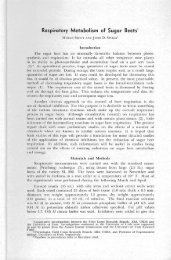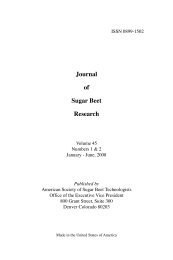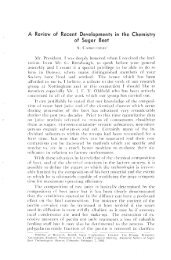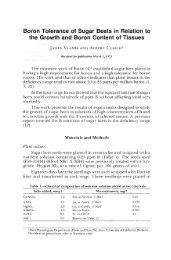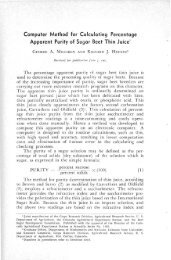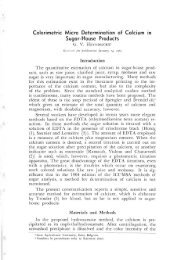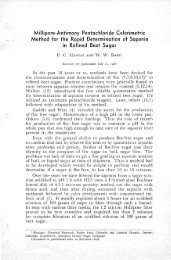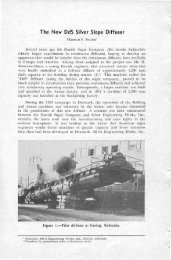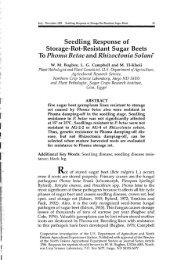Low Raw Sugar Crystallization in Connection With Affination - Vol
Low Raw Sugar Crystallization in Connection With Affination - Vol
Low Raw Sugar Crystallization in Connection With Affination - Vol
Create successful ePaper yourself
Turn your PDF publications into a flip-book with our unique Google optimized e-Paper software.
<strong>Low</strong> <strong>Raw</strong> <strong>Sugar</strong> <strong>Crystallization</strong> <strong>in</strong> <strong>Connection</strong> <strong>With</strong><br />
Aff<strong>in</strong>ation<br />
HAL L. MEMMOTT A N D E. CLARK .J 0'. V. S'<br />
Received f a>' publicaiion ApTil J, 1962<br />
Introduction<br />
S<strong>in</strong>ce the advent of the modern sugar <strong>in</strong>dustry, crystallization<br />
has always been given major consideration. In recent years many<br />
<strong>in</strong>vestigators have studied the subject with reference to sugar boil<strong>in</strong>g.<br />
The objectives have been many and varied such as: pan<br />
design, steam economy, sugar quality, pan yield, ,vorkability of<br />
low grade products and overall sugar recovery. In 1960, a sugar<br />
boil<strong>in</strong>g program was started at the Utah-Idaho <strong>Sugar</strong> Company.<br />
The objectivt: was to improve the quality and yield of low raw<br />
sugar with the f<strong>in</strong>al objective of aff<strong>in</strong>at<strong>in</strong>g this sugar. The end<br />
result desired was to <strong>in</strong>crease sugar end capacity without major<br />
expenditures for additional equipment. The plan was to standardize<br />
on improved gra<strong>in</strong><strong>in</strong>g and boil<strong>in</strong>g procedures that would give<br />
higher purity sugar with large r and more even crystals. This<br />
better sugar should purge more reaClily and thus give the needed<br />
<strong>in</strong>crease <strong>in</strong> pl ant capacity. The Moses Lake, 'Wash <strong>in</strong>gton, factory<br />
was chosen for the <strong>in</strong>itial experimental work on this problem.<br />
Description of Equipment<br />
The Moses Lake factory is equipped with two II-foot diameter<br />
calandria pans of 1,200 cubic feet ca pacity (Figure 1) used to<br />
boil the low raw sugar. These pans are cross-connected with an<br />
8-<strong>in</strong>ch l<strong>in</strong>e and valve for splitt<strong>in</strong>Q,' pans. Both are equipped with<br />
mechanical circulators driven from the b ottom. The controls<br />
(See Figure 2) <strong>in</strong>clude an absolute pressure controller, a density<br />
controller, a BPR (boil<strong>in</strong>g po<strong>in</strong>t rise) recorder, and a leyel recorder.<br />
Attached to the pan is a microscope so that the <strong>in</strong>side<br />
contents of the pan can be magnified and viewed dur<strong>in</strong>g tl-> e<br />
'whole boil<strong>in</strong>g period. The microscope has a light source <strong>in</strong>side<br />
the pan that sh<strong>in</strong>es through the juice and crystals, giv<strong>in</strong>g an<br />
excellent illum<strong>in</strong>ated field.<br />
The massecuite is dropped <strong>in</strong>to a surge tank 'where the RDS<br />
is adjusted to the crystallizer RDS before it is pumped <strong>in</strong>to the<br />
cont<strong>in</strong>uous crystallizers. This requires that the pan RDS be<br />
determ<strong>in</strong>ed <strong>in</strong> the laboratory and the amount of water to be added<br />
to the surge tank calculated from the RDS of the pan as dropped.<br />
After the proper amount of water has been added and mixed<br />
with the massecuite, the massecuite is pumped to the cont<strong>in</strong>uous<br />
1 Chemical Eng<strong>in</strong>eer, Utah,Idaho <strong>Sugar</strong> Companv, Salt Lake Citv, Utah. ann Factory<br />
Super<strong>in</strong>tendent, Utah -Idaho <strong>Sugar</strong> Company, Moses l.ake, WaSh<strong>in</strong>gton, respecti vely.
VOL. 12, No.4, JANUARY 1963<br />
SPLITTING LlN (<br />
COtl TlNUO US CR Y.!ii r.L Ul Uts<br />
BBBBD<br />
Figure I.-Diagram show<strong>in</strong>g equipment used <strong>in</strong> low raw sugar<br />
crystallization.<br />
crystallizers. These are the conventional jacketed-type crystallizers<br />
equipped with <strong>in</strong>ternal cool<strong>in</strong>g connected together so that the<br />
massecuite flows <strong>in</strong> parallel through two sets of eight s<strong>in</strong>gle<br />
cqistallizers connected <strong>in</strong> series. Both the jacket and cool<strong>in</strong>g arms<br />
are used to cool the massecuite. The arms turn at I" RPM and<br />
the cool<strong>in</strong>g water is about 20° C. From the bottom of the last or<br />
eighth crystallizer on each side, the massecuite drops <strong>in</strong>to two<br />
separate mixers- one for each set of crystallizers. Ten 42<br />
<strong>in</strong>ch X 24 <strong>in</strong>ch Roberts centrifugals, five under each mixer,<br />
operat<strong>in</strong>g at 1,600 RPM, handle all the low raw massecuite.<br />
Procedure<br />
From the start of the sugar boil<strong>in</strong>g program it was evident<br />
that <strong>in</strong> order to make each arid every pan produce good low raw<br />
sugar, the proper amount of gra<strong>in</strong> had to be established <strong>in</strong> each<br />
pan. The method previously used for gra<strong>in</strong><strong>in</strong>g - powdered sugar<br />
and air - left much to be desired. Several gra<strong>in</strong><strong>in</strong>g methods 'were<br />
attempted <strong>in</strong>clud<strong>in</strong>g: fondant and isopropyl alcohol, fondant and<br />
289
VOL. 12, No.4, JANUARY 1963<br />
291<br />
the crystals are of maximum size. As soon as the charge is pulled<br />
<strong>in</strong>to the pan, the agitator is started and the steam is turned on.<br />
The charge is boiled down until the boil<strong>in</strong>g po<strong>in</strong>t rise reads go C.<br />
This supersaturation po<strong>in</strong>t can be observed through the pan<br />
microscope by putt<strong>in</strong>g a few coarse crystals <strong>in</strong> the gra<strong>in</strong><strong>in</strong>g charge<br />
just prior to the time when saturation is reached and not<strong>in</strong>g<br />
when the crystals just develop sharp edges.<br />
At this po<strong>in</strong>t the pan is seeded with 275 to 300 milliliters of<br />
milled seed (See Figure 3) and th en as soon as the crystals take<br />
dist<strong>in</strong>ct shape as observed through the pan microscope (BPR<br />
11 ° C), the steam valve to the calandria is turned back to Yi2<br />
Figure 3.-Photographs of cr ystals as they appear through the pan<br />
microscope. Upper left-crystals at seed<strong>in</strong>g time, upper right-crystals<br />
when steam rate is reduced, center left-crystals when feed is started, center<br />
right-crystals when pans are split. lower left-crystals when feed is shut<br />
off. lower right-crystals when pan is brixed.



